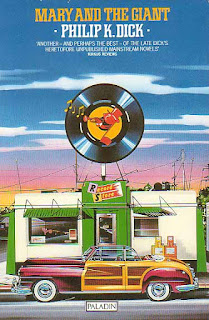 Our Friends from Frolix 8, by Philip K. Dick, 1970.
Our Friends from Frolix 8, by Philip K. Dick, 1970.Among Dick's 1960s novels, this one does not seem to get much love. It may be because there is a strong air of depression about the main character, Nick Appleton. He is a tire regroover, an occupation that one might be surprised still exists in the 22nd century, but it fits the personality. Nick is in love with a 16-year-old revolutionary guttersnipe, Charlotte, for whom he eventually leaves his wife and son.
There are some tragic and absurd deaths and perhaps not as much humor as we are used to in a Dick novel. Characters have a tendency to rattle on endlessly, seemingly without purpose. Another cause for disillusionment about this book may be the ending, as it seems to resolve very little.
Of more interest is the sociological layering of this future world. There are four categories of people in this world: Old Men, who possess normal intelligence but are passive and servile; Under Men, who are basically rebels to the authoritarian social order; New Men, who have highly developed brains; and Unusuals, who have advanced psi powers such as telepathy. The News and the Unusuals run this world with a tight grip using the PSS, an elite police corps also known as Pissers.
There is a type of character we have encountered in other Dick novels such as The Simulacra and Now Wait for Last Year. It is the conflicted world leader., this time named Willis Gram, who is able to enforce his despotic rule through telepathic powers. For no good reason he falls in love with Charlotte, who is an Under Man, and such a martial-arts whiz that she escapes from four Pisser guards that Gram has assigned to her. This intersection plunges Nick into the center of the political plot and into an "advisor" role of sorts to Gram.
The leader of the Under Men, Thors Provini, has been away on a long space journey for decades, and is returning with a giant protoplasmic alien in tow, Morgo Rahn Wilc, from the planet Frolix 8. This alien has extraordinary powers and upon return of Provini's ship to earth the Frolixan is able to scan the minds of the New Men and the Unusuals and in an instant reduce them to childish idiocy.
It might seem that this is an overly easy solution to a difficult problem. The authoritarian government is toppled, as it deserved to be, and the unempathetic brainiacs, the New Men or double-domers as they are called, are put out of business with just a bit of mental sabotage on the part of Morgo. Besides the political plot finding some resolution, however, the existential plight of Dick's characters remains tenuous. It's not a feelgood book.
But Dick's creations always fascinate beyond what we think they should, given the technical problems we might perceive in the writing. It has something to do with the fact that he wrote so many novels and they tend to run together in the mind, because they share many elements of a background reality. And a book like Our Friends from Frolix 8 benefits from that.






